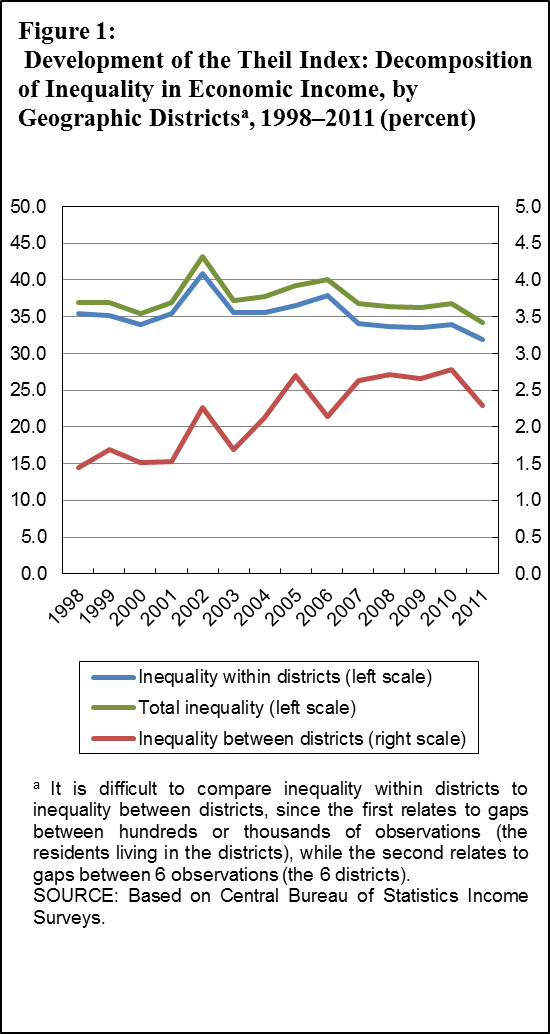![]() To view full press release as a Word document
To view full press release as a Word document
Over the last decade, as a result of agglomeration, the concentration of population in the central district of the country has increased steadily, while in all other districts, the balance of migration has been negative.[1] This process was accompanied by a concentration of higher-quality jobs in the center of the country (See Chapter 5), and led to an increase in housing prices in that district. This box examines whether these processes have expanded the economic gaps between the center of the country and the periphery, and whether they have created socio-economic stratification.
The box approached these questions by examining the development of income inequality, using the Theil index—an accepted tool for such analyses that allows dividing the population into groups and decomposing total inequality into “between group” and “within group” components.[2] Using the Theil index in relation to districts allows the presentation of two indices: The first relates to gaps between districts and is calculated on the basis of the average income in each district, and the second relates to gaps within the districts and is calculated on the basis of the weighted average of the level of inequality in each district. The sum of these two indices reflects the total inequality in the population.
[1] In other words, the number of people who left the districts exceeded the number of people who moved into the districts. More information appears in Table 2.15 of the Statistical Abstract of Israel, 2013.
[2] Milanovic, 2005; Theil, 1989; Akita, 2000; Braun, 1988.
[3] The Central Bureau of Statistics Income Surveys distinguish between seven districts: Jerusalem, North, Haifa, Center, Tel Aviv, South, and Judea and Samaria. There is a lack or a shortage of observations in the data for Judea and Samaria for some years. As such, the district was removed from the calculations. The Income Surveys include the variable for division into districts since 2004. Until then, the observations were classified by districts by matching the community label with the district to which it belonged. There was no community symbol for about 15 percent of the sample during those years. Due to the changes that took place in 2012 in the Income and Expenditure Surveys, developments that took place following 2011 cannot be analyzed comparatively.
[4] In 2005, a number of communities in the South and the North were added to the list of communities entitled to tax benefits. In 2012, an easement was added for residents of the city of Eilat, within the framework of the Free Trade Zone Law. In 2009, the government decided on a path of gradual reduction in the tax credits awarded to communities, which relates to the years 2012–16. More information appears in Section 11 of the Income Tax Ordinance.
[5] To illustrate the dimensions of the Theil index: Akita (2000) found that between 1990 and 1994, inequality between districts in China increased sharply, by about 3 percentage points (0.029 in absolute numbers). Milanovic (2005) assesses the development of the Theil index of inequality between districts in a number of major countries, and indicates that between 1990 and 2000 there was an increase in India and China—and a decline in Brazil— of between 3 and 5 percentage points. Inequality between districts in Israel increased between 1998 and 2010 by 1.3 percentage points.
